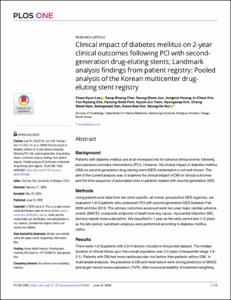KUMEL Repository
1. Journal Papers (연구논문)
1. School of Medicine (의과대학)
Dept. of Internal Medicine (내과학)
Clinical impact of diabetes mellitus on 2-year clinical outcomes following PCI with second-generation drug-eluting stents; Landmark analysis findings from patient registry: Pooled analysis of the Korean multicenter drug-eluting stent registry
- Alternative Author(s)
- Lee, Cheol Hyun; Hwang, Jong Min; Kim, In Cheol; Cho, Yun Kyeong; Park, Hyoung Seob; Yoon, Hyuck Jun; Kim, Hyung Seop; Nam, Chang Wook; Han, Seong Wook; Kim, Kwon Bae; Hur, Seung Ho
- Journal Title
- PLoS One
- ISSN
- 1932-6203
- Issued Date
- 2020
- Abstract
- Background:
Patients with diabetes mellitus are at an increased risk for adverse clinical events following percutaneous coronary interventions (PCI). However, the clinical impact of diabetes mellitus (DM) on second-generation drug-eluting stent (DES) implantation is not well-known. The aim of the current analysis was to examine the clinical impact of DM on clinical outcomes and the time sequence of associated risks in patients treated with second-generation DES.
Methods:
Using patient-level data from two stent-specific, all-comer, prospective DES registries, we evaluated 1,913 patients who underwent PCI with second-generation DES between Feb 2009 and Dec 2013. The primary outcomes assessed were two-year major cardiac adverse events (MACE), composite endpoints of death from any cause, myocardial infarction (MI), and any repeat revascularization. We classified 0-1 year as the early period and 1-2 years as the late period. Landmark analyses were performed according to diabetes mellitus status.
Results:
There were 1,913 patients with 2,614 lesions included in the pooled dataset. The median duration of clinical follow-up in the overall population was 2.0 years (interquartile range 1.9-2.1). Patients with DM had more cardiovascular risk factors than patients without DM. In multivariate analyses, the presence of DM and renal failure were strong predictors of MACE and target-vessel revascularization (TVR). After inverse probability of treatment weighting (IPTW) analyses, patients with DM had significantly increased rates of 2-year MACE (HR 2.07, 95% CI; 1.50-2.86; P <0.001). In landmark analyses, patients with DM had significantly higher rates of MACE in the early period (0-1 year) (HR 3.04, 95% CI; 1.97-4.68; P < 0.001) after IPTW adjustment, but these findings or trends were not observed in the late period (1-2 year) (HR 1.24, 95% CI; 0.74-2.07; P = 0.41).
Conclusions:
In the second-generation DES era, the clinical impact of DM significantly increased the 2-year event rate of MACE, mainly caused by clinical events in the early period (0-1 year). Careful observation of patients with DM is advised in the early period following PCI with second-generation DES.
- Department
- Dept. of Internal Medicine (내과학)
- Publisher
- School of Medicine (의과대학)
- Citation
- Cheol Hyun Lee et al. (2020). Clinical impact of diabetes mellitus on 2-year clinical outcomes following PCI with second-generation drug-eluting stents; Landmark analysis findings from patient registry: Pooled analysis of the Korean multicenter drug-eluting stent registry. PLoS One, 15(6), e0234362. doi: 10.1371/journal.pone.0234362
- Type
- Article
- ISSN
- 1932-6203
- Appears in Collections:
- 1. School of Medicine (의과대학) > Dept. of Internal Medicine (내과학)
- 파일 목록
-
-
Download
 oak-2020-0531.pdf
기타 데이터 / 889.27 kB / Adobe PDF
oak-2020-0531.pdf
기타 데이터 / 889.27 kB / Adobe PDF
-
Items in Repository are protected by copyright, with all rights reserved, unless otherwise indicated.